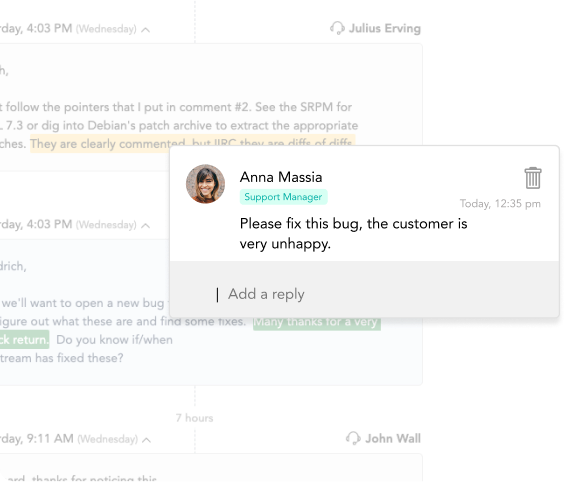
Mar 8, 2022
How to Use Salesforce and SupportLogic for Proactive Customer Support
artificial intelligenceB2B supportcustomer escalationscustomer experience
When plugged into Salesforce, SupportLogic SX enables Service Cloud users to deliver proactive customer support at scale. Read on to learn how.
With proactive support, B2B companies drive customer satisfaction by anticipating escalations rather than waiting for demands and problems to occur. But how do you know what customers will want? The answer is in combining Salesforce Service Cloud with SupportLogic.
SupportLogic SX is a cloud-based, predictive analytics platform that uses artificial intelligence (AI) and natural language processing (NLP) to analyze customer interactions and deliver the intelligence needed to resolve issues before they happen. The platform transforms case data into actionable intelligence.
SupportLogic SX has the power to identify trends in your customer data—including the unstructured data hidden within emails, text logs, live chats, and phone calls. When plugged into Salesforce, it enables Service Cloud users to deliver proactive customer service at scale. In this article, you’ll learn how to use Salesforce with SupportLogic SX to power proactive customer support.
Deliver actionable insights to Service Cloud agents
Lack of visibility can be a pain point for support organizations. According to the 2020 Salesforce State of Service report, most support teams give their team members a view of “customer interactions” across departments like sales and marketing. However, distilling all this information for agents remains a sticking point. Just under half (48%) of agents say they can find what they need on a single screen.
Distilling customer data is what SupportLogic SX was built to do. Our SX platform extracts Salesforce customer signals in real-time and provides a 360-degree view of a customer’s case history, previous support interactions, renewal status, and emerging patterns—all within a single dashboard.
By integrating SupportLogic SX with Salesforce Service Cloud, managers can easily access real-time customer analytics and the history of each case. Working with Salesforce, our platform sorts through myriad attachments, records, and case data to find the needle in the haystack—whether it’s a product bug, an issue with customer onboarding, or a high-value account at risk of churning.

Armed with deeper insights, agents can then act on customer issues and potential blockers proactively.
Use predictive alerts to prevent Salesforce escalations
Let’s look at how to use Salesforce with SupportLogic to predict escalations and send alerts about them.
When SupportLogic is connected to a Salesforce Service Cloud system, it begins extracting Salesforce customer signals almost immediately. The SX platform uses AI and NLP to analyze structured and unstructured customer data—i.e., ticket information combined with customer messages, comments, and case updates. The platform then proactively determines the likelihood and urgency of potential escalations in Salesforce from these customer signals.
Essentially, SupportLogic SX identifies customers’ most urgent situations early on in the support process, so agents can intervene. By identifying the Salesforce customer signals, or factors, that are driving the case toward escalation, the system helps agents take the right pre-emptive actions.

To understand the value of the integration, consider two scenarios.
A support manager sees in Service Cloud that a high-value customer case was escalated a day ago. The manager jumps into escalation management mode. They confer with frontline agents and sift through case data to identify the root cause: an unresolved software issue that’s causing a slowdown in the customer’s system. The manager works with support and engineering team members to resolve this issue.
By that point, though, several days have passed, and the customer is at risk of churning. Now the manager must loop in high-level members of the executive and customer success teams, perhaps even the company CEO, to placate and retain the customer.
Now imagine the escalation never happened in the first place.
In this alternative scenario, SupportLogic extracts Salesforce customer signals and sends an alert that the case is trending toward escalation. The manager sees this “likely to be escalated” alert when they log into SupportLogic SX. SupportLogic pinpoints the root issue—a bug in the latest software update—and flags it as a high-value customer account that demands immediate attention. The support manager takes swift action and resolves the issue in under an hour.
Salesforce users leverage these predictive alerts to proactively handle escalations. Data integration company Qlik integrated SupportLogic SX with its Salesforce system to create an early warning system for critical cases. With this process, Qlik reduced customer escalations by 30% in just six months.
Swarm cases and collaborate with experts that don’t have access to Service Cloud
Exceptional customer service depends on an entire company, not just the customer support team. Interdepartmental collaboration is vital—and today’s customers expect it. According to the 2020 Salesforce State of Service report, 76% of customers “expect consistent interactions across departments.” However, 53% of customers feel like sales, service, and marketing groups don’t share information.
SupportLogic SX powers collaboration and communication between support and other departments—like product, engineering, and customer success. Using SupportLogic SX, support agents can address even the most complex customer issues by swarming and collaborating in ways Service Cloud doesn’t easily allow.

SupportLogic also doesn’t cap the number of users, so everyone in your company can access customer data in real time—from product engineers to the VP of customer success. Through SupportLogic’s dashboard, you can invite subject matter experts and other team members to provide additional customer context and resolve issues more quickly.
Improve Salesforce backlog management
Lastly, let’s look at how to use Salesforce with SupportLogic SX to reduce the dreaded case backlog in Salesforce.
With SupportLogic, managers can track Salesforce case backlog with customer signals that aren’t accessible in Salesforce alone—including customer sentiment score, attention score, case age, and last response. They can also create custom backlog lists based on case sentiment, urgency, and signals such as escalations. And instead of switching between records or dashboards in Salesforce, case information is just one click away.
When SupportLogic SX is integrated with Salesforce, users typically start seeing improvements with backlog management and case resolution in a matter of weeks—not months. The SX platform can help reduce case review time by up to 60% and minimize the (costly) breach of Service Level Agreements (SLAs). For instance, software company Databricks saw a 40% reduction in SLA misses after plugging SupportLogic into its Salesforce system.
Don’t miss out
Want the latest B2B Support, AI and ML blogs delivered straight to your inbox?






